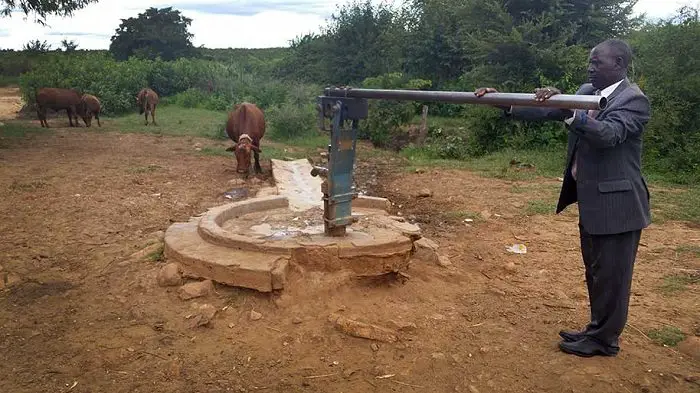A combination of drought, ageing infrastructure, pollution and a ballooning population have conspired to make it almost impossible for the country to access adequate water supplies before the onset of the next rainfall season in November prompting the country to run into a water rationing crisis.
Zimbabwe is in the grips of a second year of drought, exacerbated by an El Nino weather phenomenon.
This has left almost a third of the population in serious need of both food and water.
More than four million Zimbabweans would be in dire need of food aid by year end at a time when the national dam level average is hovering around 48, 1 percent, which is way below the normal average of 65 percent.
The critical low dam water levels are linked to the effects of the El Nino-induced drought, as well as human actions that have caused siltation; while urban housing expansion has seriously affected water availability for both domestic and agricultural use.
Access to safe and reliable drinking water is one of the most basic needs of human society, but the resource is now scarce with households being forced to rely on unprotected sources, contributing to the increase in health risks related to water-borne diseases.
As the water levels in dams countrywide continue to dwindle, the Zimbabwe Humanitarian Situation Report notes that water levels in all the country’s seven catchment areas are about 18 percent below the expected capacity and municipalities are expected to implement water restrictions soon.
The worst affected catchments are Save and Runde which are recording storage capacity levels of 44,8 percent and 21,8 percent respectively, according to the Zimbabwe National Water Authority (ZINWA).
These two catchments cover most of Masvingo and Manicaland provinces and parts of Matabeleland South, Midlands, and Mashonaland East.
Dam levels in the Mazowe catchment, which covers mainly the Mashonaland Central province, now stand at 73,3 percent.
Mwenje, Mwarazi and Mufurudzi dams are some of the major reservoirs in the catchment.
Dams in the Gwayi catchment in Matabeleland North are below their expected average of 66,2 percent at 57,9 percent.
Sanyati and Mzingwane catchment areas are both below 70 percent at 55 percent and 59 percent respectively.
In light of these depressed water levels, ZINWA has appealed to all water users across the country to use the available resources efficiently and sparingly.
The Rural WASH Information Management System reports that an estimated 11 000 sources of water, boreholes and wells have reduced their yield, while over 750 perennial sources reported a reduction in their capacity or are drying up due to the drought situation, reducing access to safe water for approximately 3,4 million people.
Beside the effects of the drought on water supply, urbanisation has also impacted negatively on the capacity of water sources to adequately supply the resource.
Development Governance Institute director and consultant, Kudzai Chatiza, said it was impossible for anyone to stop urbanisation not just in Zimbabwe, but globally.
“What is needed is to harness urban resources for water development. It is a combination of effective long-range infrastructure planning and implementation anchored on local authority revenues, state funding, properly engaged private sector investment and sustainable development particularly of catchments,” Chatiza said.
For Harare, Chitungwiza and Norton, supply dams namely Chivero and Manyame, as well as the smaller Harava and Seke dams have not been able to meet the demand for water due to the growing population as the construction of Kunzvi Dam remains a pipedream.
Across the country, growth points in all the 63 districts are expanding at a phenomenal rate with areas such as Goromonzi, Mupandawana, Sanyati and Checheche being among the settlements that are putting immense strain on the available water resources.
Zimbabwe has about 10 000 dams, which are facing collapse due to poor maintenance, according to a survey conducted by a South African consultancy firm, ARUP.
The poor state of the dams has also been exacerbated by siltation with Mudzi Rural District Council reporting that its Nyamuwanga Dam, supplying water to Kotwa Growth Point, has been affected by heavy siltation and the drought.
Early this month, the district sent an SOS as Kotwa, with a population of about 20 000, is left with just three weeks’ supply of water.
The growth point only has six boreholes which are also shared by surrounding rural communities.
Siltation has become a major challenge in all major dams and rivers across the country.
“The economic challenges have forced citizens (rural and urban) to exert undue pressure on the environment. For instance, electricity shortages and absence of alternative rural energy are key factors behind rising demand for (wood) fuel. Land and environmental management challenges have also arisen from the land reform that resulted in loss of forest cover in some areas leading to siltation of water bodies. Artisanal mining activities have also affected watercourse and bodies,” said Chatiza.
ZINWA concurred that siltation has become a major problem affecting water availability in the country’s major dams
“While the current water situation is largely attributable to the poor rains, the siltation of some of the country’s dams has also compromised the dams’ ability to store more water. To this end, ZINWA, through its parent Ministry, the Ministry of Environment, Water and Climate, recently launched the National De-silting Programme under the Food for Work Scheme, which will see locals in food insecure areas helping with the removal of silt from small dams in their areas,” ZINWA said.
ZINWA will also embark on a project to de-silt and rehabilitate 70 dams that have been adversely affected by silt. Silt surveys have so far been conducted at Chimhanda Dam in Rushinga and the Jotsholo Weir in Matabeleland North. Another silt survey will be carried in the coming week at Zimunya Dam in Manicaland.
Water scarcity is predicted to worsen across southern Africa, with a 2012 World Bank report predicting that dam and lakes levels will fall by up to 50 percent by 2080 due to the effects of climate change.

